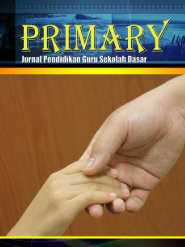Development of EKSIS (ebook ekosistem) to introduce the ecosystem concept in class 3 elementary school
DOI:
https://doi.org/10.33578/ep3d7c44Abstract
This study aims to develop and validate the EKSIS product, a learning media based on ecosystem materials designed to introduce the concept of ecosystems to third-grade elementary school students. The research method used is Design and Development (D&D), with the ADDIE development model consisting of five stages: Analysis, Design, Development, Implementation, and Evaluation. The validation instrument consists of a five-point Likert scale assessment sheet to measure the quality of the product from two main aspects: product design and content material. The validation results show that EKSIS received an average score of 5 for both assessed aspects, placing it in the "excellent" category. The product was deemed relevant to learning needs, supported curriculum achievements, and had an effective design that engaged students and enhanced their understanding of ecosystem materials. Based on these findings, EKSIS is considered suitable for use in the learning process. The use of this product is expected to help introduce the concept of ecosystems and provide an engaging and in-depth learning experience for students. This research significantly contributes to developing innovative learning media that align with educational needs in the digital era.
References
Aeni, A. N., Hanifah, N., Djuanda, D., Maulana, M., Erlina, T., Dewi, D. P., Hadi, F. L., & Ramadhani, S. (2024). Penguatan Kompetensi Guru PAI melalui Pelatihan Pembuatan Aplikasi BETA (Belajar Dari Peta) sebagai Media Edukasi Doa-doa Harian bagi Siswa SD. Publikasi Pendidikan, 14(2), 135. https://doi.org/10.26858/publikan.v14i2.60157
Aeni, A. N., Rohaiphy Aleyda Kana, Ratih Ambar Sari, & Amanda Claudia Putri. (2024). Pengembangan Flipbook TAMAN “Terpujinya Akhlak Mulia Ahmad Dahlan” pada Pembelajaran PAI Kelas 4 di SDN Babakan Hurip. Al-Kharaj: Jurnal Ekonomi, Keuangan & Bisnis Syariah, 6(8). https://doi.org/10.47467/alkharaj.v6i8.2263
Aeni, A. N., Diffa Aprilia, Z., Yeni Suhartini, D., & Sulistiani, R. (2022). PENGEMBANGAN APLIKASI “CERMIN” UNTUK MENANAMKAN PENDIDIKAN KARAKTER DALAM PERSPEKTIF ISLAM DI SEKOLAH DASAR KELAS V.
Aeni, A. N., Hanifah, N., Djuanda, D., Maulana, M., Erlina, T., Dewi, D.P., Hadi, F.L., Ramadhani. S. (2024). ”Meningkatkan Keterampilan Abad 21 Guru SD Melalui Pelatihan Convert Powerpoint Menjadi Media Pembelajaran Aplikasi Android”.
Amelia, R. R., Nugraha, R. G., & Syahid, A. A. (2024). Pengembangan E-book “Kawan” dalam Pembiasaan Menyanyikan Lagu Wajib Nasional pada Siswa Kelas IV Sekolah Dasar. Ideguru: Jurnal Karya Ilmiah Guru, 9(3), 1154–1160. https://doi.org/10.51169/ideguru.v9i3.1060
Anderson, L. W., & Krathwohl, D. R. (Eds.). (2019). A Taxonomy for Learning, Teaching, and Assessing: A Revision of Bloom's Taxonomy of Educational Objectives.
Anggraeni, N. O., Abidin, Y., & Wahyuningsih, Y. (n.d.). Pengembangan Media Pembelajaran Permainan Ular Tangga Digital Pada Materi Keragaman Budaya Indonesia Mata Pelajaran IPS Kelas IV Sekolah Dasar.
Allen, M. W. (2014). Leaving ADDIE for SAM: An Agile Model for Developing the Best Learning Experiences.
Azhary, P. A., Hanifah, N., & Aeni, A. N. (n.d.). Volume 5, Nomor 2, Desember 2024 PENGEMBANGAN APLIKASI BERBASIS ANDROID ALE “ASEAN LEARN” UNTUK SISWA SEKOLAH DASAR KELAS VI.
Bransford, J. D., Brown, A. L., & Cocking, R. R. (2000). How People Learn: Brain, Mind, Experience, and School.
Clark, R. C., & Mayer, R. E. (2021). E-Learning and the Science of Instruction: Proven Guidelines for Consumers and Designers of Multimedia Learning (5th ed.).
Fojtik, R. (2015). Ebooks and Mobile Devices in Education. Procedia - Social and Behavioral Sciences, 182, 742–745. https://doi.org/10.1016/j.sbspro.2015.04.824
Gagné, R. M., Wager, W. W., Golas, K. C., & Keller, J. M. (2018). Principles of Instructional Design (5th ed.).
Garcia, I., Pacheco, C., & Garcia, G. (2010). A platform of constructivist learning in practice: Computer literacy integrated into elementary school. International Journal of Emerging Technologies in Learning, 5(2), 15–24. https://doi.org/10.3991/ijet.v5i2.1040
Gee, J. P. (2008). What Video Games Have to Teach Us About Learning and Literacy.
Hakkarainen, K., Palonen, T., Paavola, S., & Lehtinen, E. (2020). Communities of Networked Expertise: Professional and Educational Perspectives.
Kirkwood, A., & Price, L. (2019). Technology-Enhanced Learning: Critiquing the Impact on Student Learning.
Kurniasih, Y., Vivanti Sigit, D., & Handayani Kurniati, T. (2021). Discovery learning model ebook development on ecosystem materials for distance learning. EDUSAINS, 13(2), 119–128. https://doi.org/10.15408/es.v13i2.21876
Mayer, R. E. (2021). Multimedia Learning (3rd ed.).
Mayer, R. E. (2003). Elements of a Science of E-Learning
Downloads
Published
Issue
Section
License
Copyright (c) 2024 Rucita Ayu Wijaksana, Ani Nur Aeni, Dety Amelia Karlina (Author)

This work is licensed under a Creative Commons Attribution-NonCommercial-ShareAlike 4.0 International License.
Licence
Copyright @2017. This is an open-access article distributed under the terms of the Creative Commons Attribution-NonCommercial-ShareAlike 4.0 International License (http://creativecommons.org/licenses/by-nc-sa/4.0/) which permits unrestricted non-commercial used, distribution and reproduction in any medium

This work is licensed under a Creative Commons Attribution-NonCommercial-ShareAlike 4.0 International License.



